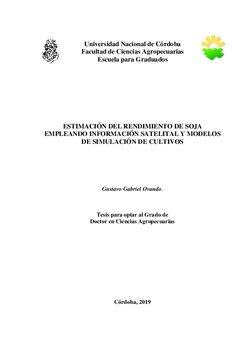| dc.contributor.advisor | Ravelo, Andrés C. | |
| dc.contributor.author | Ovando, Gustavo Gabriel | |
| dc.date.accessioned | 2019-09-27T15:39:13Z | |
| dc.date.available | 2019-09-27T15:39:13Z | |
| dc.date.issued | 2019 | |
| dc.identifier.uri | http://hdl.handle.net/11086/12851 | |
| dc.description | Tesis (Doctor en Ciencias Agropecuarias) -- UNC- Facultad de Ciencias Agropecuarias, 2019 | es |
| dc.description.abstract | La estimación de la productividad de la soja es un dato estratégico a nivel regional.
Los modelos de cultivos proveen una descripción continua del crecimiento y desarrollo del
cultivo. La teledetección permite el monitoreo del crecimiento y desarrollo de la
vegetación en un área determinada. El objetivo general de este estudio fue predecir
parámetros biofísicos del cultivo de soja, integrando datos de teledetección del sensor
MODIS en el modelo de cultivo STICS. En diez lotes con soja de la región central de la
provincia de Córdoba se realizaron observaciones de: índice de área foliar (LAI), fracción
de la radiación fotosintéticamente activa interceptada (fIPAR), cobertura del cultivo (%C),
materia seca de la parte aérea (MS), fase fenológica, contenido de agua del suelo (HS) y
rendimiento. El modelo de transferencia radiativa PROSAIL se utilizó para generar una
base de datos que se invirtió empleando redes neuronales artificiales (ANN), con el fin de
estimar LAI a partir de valores de reflectancias de MODIS. Se forzó al modelo STICS a
tomar valores de LAI (STICS-f) y con ambos se simuló MS y rendimiento, como así
también HS. Las reflectancias simuladas con PROSAIL mostraron la evolución típica con
el incremento del LAI: un aumento de la absorción en azul y rojo e incremento en la
reflectancia NIR. La ANN con mejor desempeño en la inversión de PROSAIL consideró
como datos de entrada solamente las reflectancias en azul, rojo y NIR para estimar el LAI.
En la calibración de los coeficientes del cultivo del modelo STICS, se debió considerar las
diferentes fechas y densidades de siembra como así también la longitud del ciclo de las
variedades utilizadas. Como era de esperar, al pasar del modelo STICS a STICS-f, los
errores de estimación del LAI disminuyen (%RMSE de 29,2% a 12,2%), como así también
los errores al estimar MS; sin embargo, resultaron elevados en comparación con la
bibliografía analizada. Cuando el análisis considera solamente la materia seca vegetativa,
los errores disminuyen considerablemente. El contenido de humedad del suelo hasta 2m de
profundidad y el rendimiento, fueron estimados adecuadamente tanto con STICS como con
STICS-f, cuyos valores de %RMSE estuvieron en torno a 10%. | es |
| dc.description.abstract | The estimation of soybean productivity is a strategic information at the regional
level. While crop models provide a continuous description of crop growth, remote sensing
also allows monitoring the growth and development of vegetation also for a given area.
The general objective of this study was to predict biophysical parameters of soybean crop,
integrating remote sensing data from the MODIS sensor with the STICS crop model. At
central region of Córdoba province, observations were made, in ten plots with soybean:
leaf area index (LAI), fraction of intercepted photosynthetically active radiation (fIPAR),
crop coverage (% C), dry matter the aerial (MS), phenological stage, soil moisture content
(HS) and yield. The radiative transfer model PROSAIL was used to generate a database
that was inverted using artificial neural networks (ANN) to estimate LAI from MODIS
reflectance values. The STICS model was forced to take LAI values (STICS-f), to estimate
MS and yield, as well as HS. The simulated reflectances with PROSAIL showed the
typical evolution with the increase of LAI: an increase for the absorption in blue and red
bands and an increase in the NIR reflectance. Only data of the reflectance in blue, red and
NIR were used as input in the ANN with better performance in the inversion of PROSAIL
to estimate LAI. In the calibration of STICS model, crop coefficients for the different
sowing dates and densities as well as the cycle length of the varieties used should be
considered. As expected, when changing from STICS to STICS-f model, the LAI
estimation errors decrease (% RMSE from 29.2% to 12.2%), as well as errors in MS
estimating; however, they were high in comparison with the literature analyzed. When
considering vegetative dry matter, the errors decrease markedly. The moisture content of
the soil up to 2m depth and the yield were properly estimated with both STICS and STICS-
f, models, whose %RMSE values were around 10%. | en |
| dc.format.extent | 127 h. : fotografías, gráficos, tablas, mapa color | es |
| dc.language.iso | spa | es |
| dc.rights | Attribution-NonCommercial-NoDerivatives 4.0 Internacional | * |
| dc.rights.uri | http://creativecommons.org/licenses/by-nc-nd/4.0/ | * |
| dc.subject | Soja | es |
| dc.subject | Rendimiento de cultivos | es |
| dc.subject | Teledetección | es |
| dc.subject | Sensores remotos | es |
| dc.subject | Modelo de simulación | es |
| dc.subject | Córdoba | es |
| dc.subject | Argentina | es |
| dc.title | Estimación del rendimiento de soja empleando información satelital y modelos de simulación de cultivos | es |
| dc.type | doctoralThesis | es |





